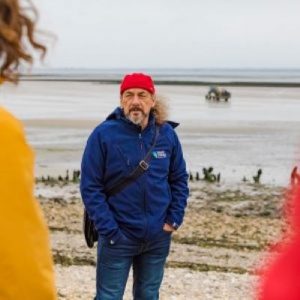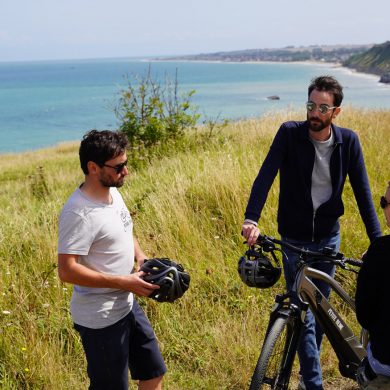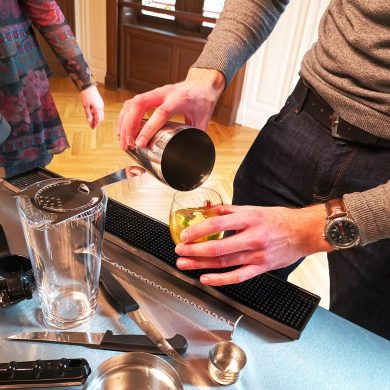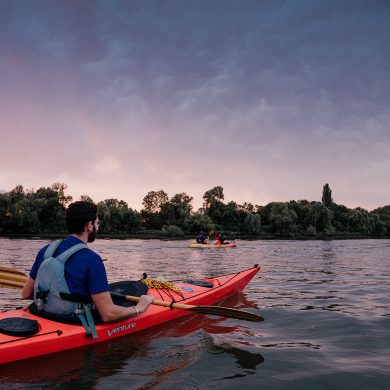Updated on 9 April 2024
Reading time: 5 minutes
There has never been a more exciting time to be an oyster lover. On the coast of Normandy, this secretive oyster world has always fascinated us. When we finally got a chance to explore a beautiful part of La Manche, my friends and I jumped at the opportunity to visit an oyster farm in the Baie des Veys. Perfect weather, delicious oysters, and a welcoming host made our visit nothing short of amazing.
Rendez-vous with an oyster farmer
Dressed with appropriate wellies and raincoats for the occasion, we are greeted by Eric Rotrou, a friendly tour guide from the Isigny-Omaha Tourist Office. Our first discovery is the amazing scale of shellfish farming in the area of Grandcamp-Maisy. We are surprised to see so many facilities and establishments linked to the oyster aquaculture industry. But it’s time to shed some light on these delicious gems of the Baie des Veys. We start by checking out the oyster beds themselves – which are attached to man-made seaside structures. Last but not least, we visit the sorting and packing facilities on the oyster farm of the Perron seafood company.
The immense bay of the Veys
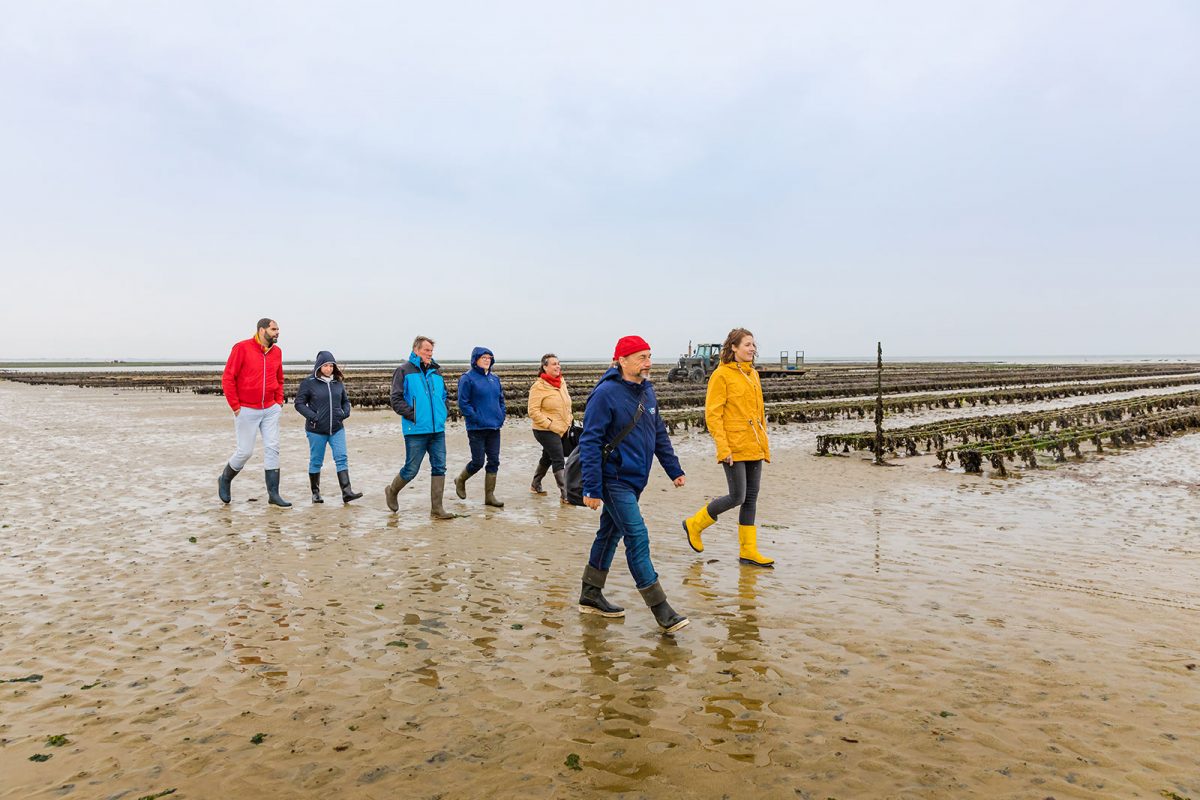
We soak up spectacular views of the Baie des Veys as we walk towards the oyster beds. The area between the coasts of Bessin and Cotentin is renowned as a biodiversity hotspot, a true haven for many species of seabirds and seals.
The estuary of the Baie des Veys was also of importance in the journey of William the Conqueror in the 11th century. Returning on horseback to his castle in Falaise, he took a shortcut through the bay to avoid going through the village of Isigny and crossing paths with Grimoult du Plessis, a Norman baron who was part of a conspiracy to assassinate him. Luckily, William had been warned and the assassination attempt failed. Grimoult was later jailed in the tower of Rouen before being executed and his land reclaimed.
After covering this eventful part of history, Eric draws our attention to the endless lines of oyster bags on top of their trestles, spreading out in the whole bay over the surface equivalent to 340 football fields. Eric provides an overview of the operations and points out oysters in various stages of growth. Do you know it takes 2 to 3 years for oysters to grow to harvest size? During that time, each bag of oyster will be manipulated at least thirteen times by the oyster farmer to develop healthily.
A thriving ecosystem
Creatures big and small inhabit this wondrous landscape. Here, the estuarine ecosystem is regulated by an almost continuous flow of water generated by the tidal movements. Oysters feed by filtering water over their gills during certain stages of the tide. Eric explains that four rivers and steams end up in the estuary, and this phenomenon enriches the water with a variety of excellent nutriments filtered by the oysters. Over the growing season, oysters are sorted by size and repositioned on different trestles accordingly. Each bag of oysters must be turned and shaken by hand to ensure oysters are separated from each other so that their shells do not fuse together. There are tens of thousands of bags requiring this procedure; and as a result, it is a full-time job for oyster growers, all year round.
The sorting Process: Oyster Grades and Sizes
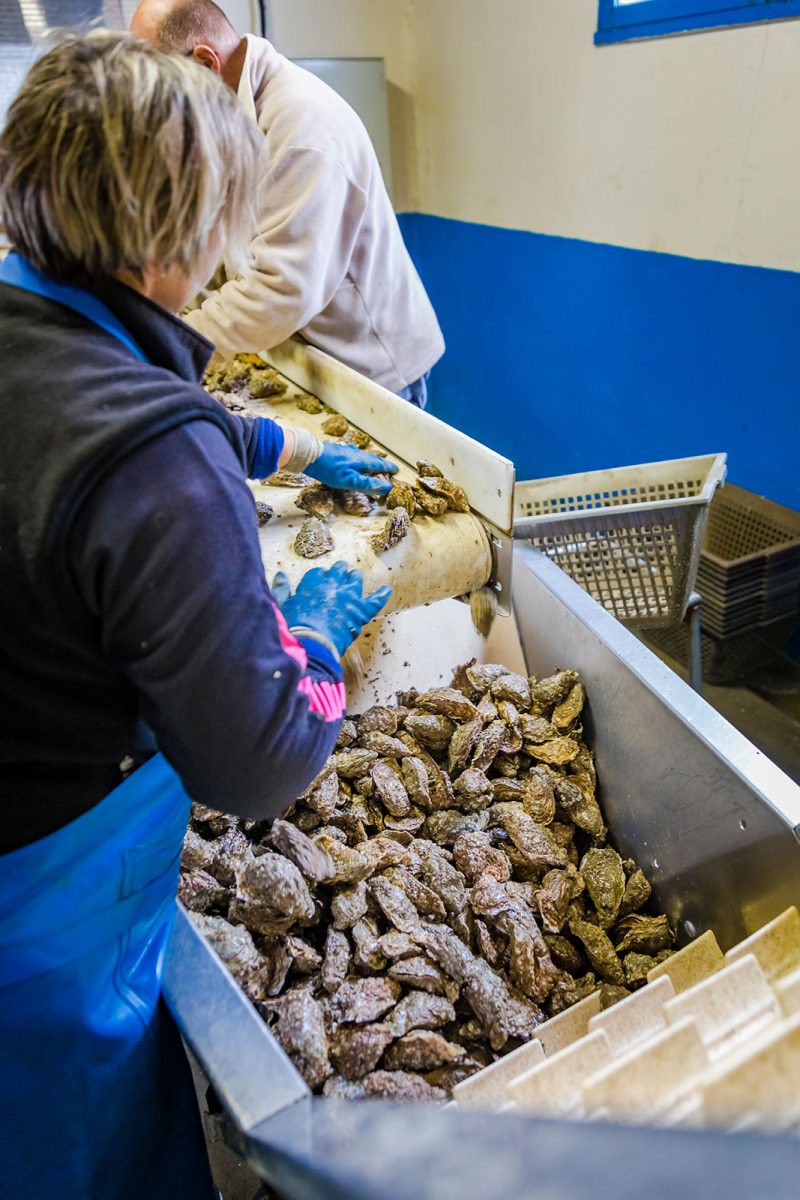

Sorting oysters by shape and size, is an important step in getting oysters to market. The weighing and selection of oysters are jobs that are performed manually: according to their size they are either placed in basins or sent to sorting. At this stage, oysters are separated from one another and repackaged in bigger bags so they continue to grow. The designations for the size of an oyster vary from 1 to 5: the higher the number, the smaller the oysters. William Perron, the oyster producer, is therefore always analyzing and forecasting the market size to make sure supply meets the demand, especially during Christmas and New Year celebrations.
Tasting fresh-out-of-the-water oysters!
No visit to an oyster farm would be complete without the sampling of these precious oysters! Eric takes us through the protocole. First, remove the water and wait a few seconds to see if it waters again. Then, move the oyster around in its liquid-filled half shell to make sure it’s detached. Taking our first slurps, the instant rush of sea water hits our palates. The oyster itself was incredibly meaty and buttery. The sharp, unmistakable mineral quality of Isigny oysters ( as they are labeled) sang out immediately. The texture was brilliantly firm, chewy, and full of life. They truly reflected the taste of the sea. We couldn’t get enough of them… and so we chatted, opened more, learned a lot and had a blast!


The Baie des Veys
The Baie des Veys is an estuary where four of the main rivers of the area come together : the Aure, the Vire, the Taute and the Douve. This immense protected natural area, where the tides come and go, is the breeding ground of the Isigny and Utah Beach oysters. Up to 10,000 tons of oysters are produced here every year.
USEFUL INFORMATION
Visit of the oyster beds in the Baie des Veys, on the shellfish farming area of Grandcamp-Maisy
Organized by Isigny-Omaha Tourist Office
16 rue Emile Demagny
14230 Isigny-sur-Mer
+33 (0)7 56 41 87 44
[email protected]
[email protected]
www.isigny-omaha-tourisme.fr
Possible tours on a horse-drawn carriage.
Visits take place with the following oyster producers: André Gilles Taillepied, Alain Pourtier, and EURL Perron.
2024 DATES
Tours are organized during school holidays.
Groups Tours are available all year round on request.
More Information at the Isigny-Omaha Tourist Office.
2024 PRICES
Adults: Walking tour 6 € / Horse-drawn carriage: 25 € per carriage
Children from 4 to 12 years old: Walking tour 3 € / Horse-drawn carriage: 15 € per carriage.
Family package Horse-drawn carriage (2 adults, 2 children): 70 €
Free for children under 4 years old
MORE INFO
Bring a windproof jacket & waterproof shoes.
This activity can be tailored to visually impaired guests on request.
All of the above information is subject to change.

